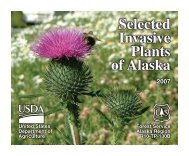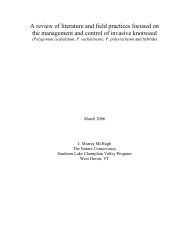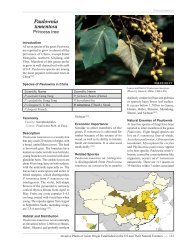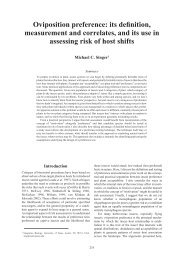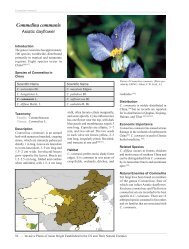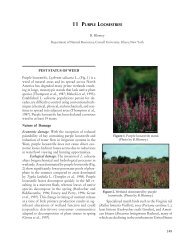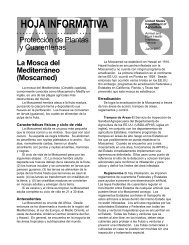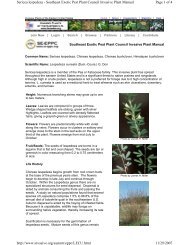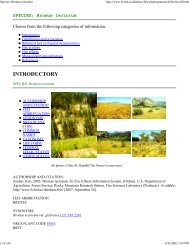5 WATERLETTUCE PEST STATUS OF WEED ... - Invasive Plants
5 WATERLETTUCE PEST STATUS OF WEED ... - Invasive Plants
5 WATERLETTUCE PEST STATUS OF WEED ... - Invasive Plants
You also want an ePaper? Increase the reach of your titles
YUMPU automatically turns print PDFs into web optimized ePapers that Google loves.
Waterlettuce<br />
are paler grayish brown with orange and dark markings.<br />
The whitish eggs are oval and flattened, appearing<br />
domelike. They are laid near edges of submersed<br />
leaf-surfaces of aquatic plants and are placed singly<br />
or slightly overlapping, often in ribbon like masses.<br />
Larvae (Fig. 7b) reside between two roundish pieces<br />
of leaves that form a sandwich-like portable case.<br />
When feeding on small plants, these cases can consist<br />
of whole leaves or even whole plants. Cases are usually,<br />
though not exclusively, constructed from the<br />
plant species on which the larva is feeding. The cases<br />
made by young larvae are waterfilled, and these larvae<br />
obtain oxygen through their skin. Cases of older<br />
larvae are airfilled. Larvae extend the anterior portion<br />
of their bodies out of the case to feed on surrounding<br />
plants. They abandon smaller cases as they<br />
grow larger, and then cut pieces from new leaves to<br />
construct larger cases.<br />
Unlike most nymphulines, larvae of S. obliteralis<br />
lack tracheal gills. The general body color is creamy<br />
white grading into brownish anteriorly (towards the<br />
segments that protrude from the case). The epidermal<br />
surface is textured with minute papillae that create<br />
a distinctive satiny appearance. The head is yellowish<br />
or brownish with patches of slightly darker<br />
coloration. Before pupation, larvae attach their cases<br />
to leaves of aquatic plants either above or below the<br />
water surface. They then spin cocoons within the<br />
cases in which to pupate.<br />
EVALUATION <strong>OF</strong> PROJECT OUTCOMES<br />
Figure 7b.<br />
Figure 7a.<br />
Figure 7. Adult (a) and larvae (b) of the<br />
waterlily leafcutter Synclita obliteralis<br />
(Walker) which feeds on waterlettuce.<br />
(Photograph courtesy of USDA, ARS<br />
<strong>Invasive</strong> Plant Research Laboratory.)<br />
Establishment and Spread of Agents<br />
Dray et al. (1990) describe the release and establishment<br />
of the weevil N. affinis, which was initially released<br />
at seven sites in southern Florida in 1987 and<br />
1988. Populations established at four of these sites<br />
within a year. By fall of 1990, the weevils had dispersed<br />
to waterlettuce-infested canals and ponds up<br />
to 25 km from initial release sites on Lake<br />
Okeechobee (Dray and Center, 1992). Collaborators<br />
with the South Florida Water Management District<br />
and the Florida Department of Environmental<br />
Protection collected infested waterlettuce plants and<br />
transplanted them into about 30 additional waterways<br />
throughout the state in the spring of 1989 (Dray and<br />
Center, 1992). The weevil also was recovered from<br />
several sites in southern Louisiana during surveys in<br />
spring and summer 1990, although how it arrived<br />
there remains unclear (Grodowitz et al., 1992). Surveys<br />
during the fall of 1991 showed N. affinis populations<br />
had become established at 45 sites in Florida<br />
and six sites in Louisiana (Dray and Center, 1993).<br />
The weevil also was released at one site in Texas in<br />
the fall of 1991 (Grodowitz et al., 1992).<br />
The moth S. pecitnicornis was released at 22 sites<br />
in southern Florida from 1990 to 1997 (Dray et al.,<br />
2001). Several provisionally established populations<br />
developed, but ultimately failed to persist (Dray et<br />
al., 2001).<br />
73


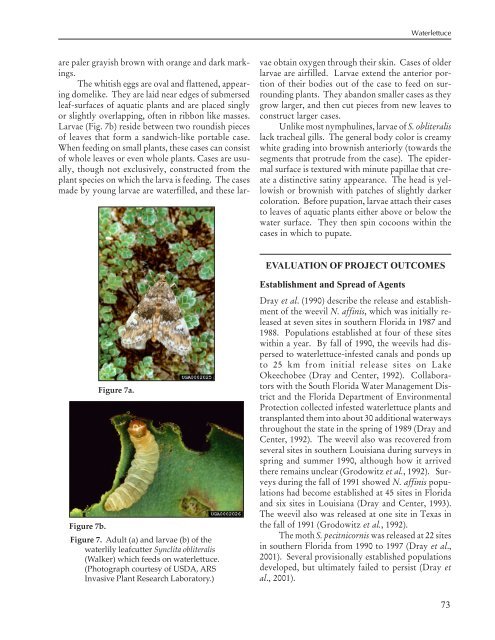


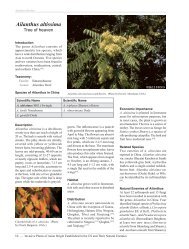
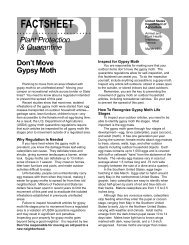
![A Guide to the Control and Management of Invasive Phragmites [PDF]](https://img.yumpu.com/27321025/1/190x190/a-guide-to-the-control-and-management-of-invasive-phragmites-pdf.jpg?quality=85)
